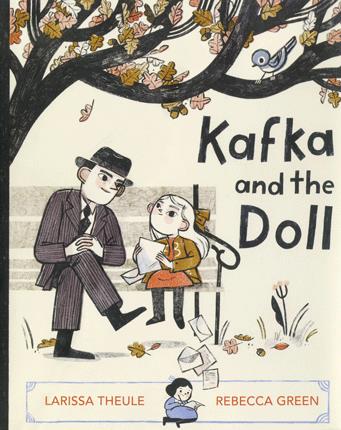| Kafka and the doll Author: Theule, Larissa | ||
| Price: $6.50 | ||
Summary:
Recounts a remarkable gesture of kindness from one of the world's most bewildering and iconic writers. In the fall of 1923, Franz Kafka encountered a distraught little girl on a walk in the park. She'd lost her doll and was inconsolable. Kafka told her the doll wasn't lost, but instead, traveling the world and having grand adventures! And to reassure her, Kafka began delivering letters from the doll to the girl for weeks.
| Illustrator: | Green, Rebecca |
Reviews:
Kirkus Reviews (01/15/21)
School Library Journal (+) (00/06/21)
Booklist (+) (02/01/21)
Full Text Reviews:
Booklist - 02/01/2021 *Starred Review* Spun from a true anecdote and likely to move adult readers as well as younger ones, this set of quiet encounters between a writer and a child has as much going on between the spare, poetic lines as in them. In the park one autumn day, Franz Kafka questions a crying child and learns that her name is Irma and that she has lost her doll, Soupsy. Assuring Irma that her doll is only traveling, Kafka rejoins her over the following days with handwritten letters signed by Soupsy that record the pleasures of taking tea in England with Peter Rabbit, strolling with Gaudí in Barcelona, and enjoying warm sfenj and mint tea in Morocco. Some days, Irma waits in vain for the kind, coughing writer (he would die of tuberculosis just a few months after their first encounter), and, for what becomes their final meeting, he brings both a blank journal and a farewell letter from Soupsy—who, it seems, is off to remotest Antarctica. The original letters are lost, but along with a biographical note, Theule supplies creatively recast versions that capture a heady sense of the wider world. Green tops off her muted scenes of button-eyed figures in, alternately, autumnal and far-flung settings. A tribute to the way words can change lives, as well as a rare glimpse of a writer most of us perhaps only think we know. - Copyright 2021 Booklist.
School Library Journal - 06/01/2021 K-Gr 2—Theule recounts the true story of Kafka, on a walk with his partner Dora, encountering a small girl named Irma crying over the loss of her doll. Kafka transforms the loss of the doll into an adventure. He tells Irma that her doll has gone on a trip and that she has sent a letter, for which he is the "volunteer postman." Sadly, he has left the letter in an overcoat at home. Irma is astounded, but is back at the park the next day awaiting him. Thus begins a series of days, turned into weeks of letters detailing the doll's travels. from having tea in England with Peter Rabbit to walking with Gaudi in Barcelona. Kafka, very ill, produces a final letter stating that the doll has gone on an expedition to Antarctica. The last image is of a grown Irma riding a camel, and with her are copies of Kafka's novels. Based on true events told to Kafka's biographer, Theule fills in the gaps with a conversational narrative, while the old-fashioned illustrations, on parchment-colored paper, deftly wind scenes of the doll with the interactions between Kafka and Irma. All the characters, real and imagined, are white. While the importance of Kafka in literature may not yet resonate with the picture-book demographic, this charmingly enhanced tale otherwise has it all: the kindness of a stranger, the loss of a beloved toy, adventures, and even closure. Back matter includes the author's notes on her changes to the tale, a brief biography of Kafka, and a short bibiliography. VERDICT A winsome tale for the young, this could also be of value in high school collections where Kafka is taught.—Katie Llera, Bound Brook Elem. Sch., NJ - Copyright 2021 Publishers Weekly, Library Journal and/or School Library Journal used with permission.



